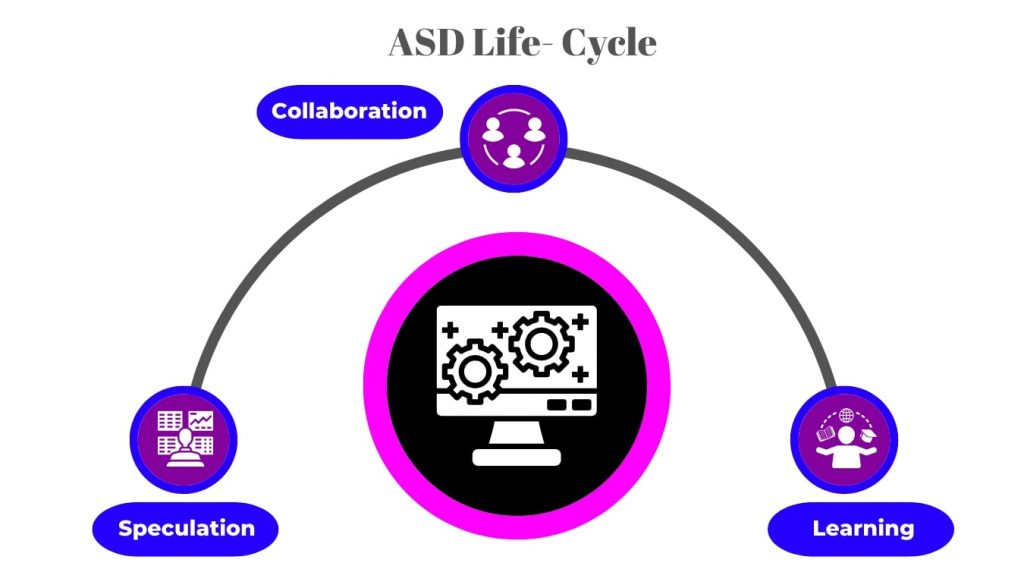
Adaptive Software Development
Adaptive Software Development (ASD) Definition
As the term suggests, adaptive software development or ASD enables development teams to adapt to the quickly changing requirements and market demands effectively. Teams can update and evolve the products by planning and learning continuously. They can do this by following the three-phase approach of speculating, collaborating, and learning.
Adaptive software development is an agile framework for designing complex software and systems.
Adaptive Software Development (ASD) is an advanced form of another agile framework, Rapid Application Development (RAD).
It was Sam Bayer and Jim Highsmith’s decision to develop the asd software.
Examples of ASD include scrum and Feature Driven Development (FDD).
Like other agile techniques, ASD helps teams be more adaptive to varying consumer needs, requirements, and market demands.

Phases of Adaptive Software Development
ASD has a three-phase approach: speculate, collaborate and learn. These phases express the versatile behavior of adaptive software development.
Speculation
Speculation is the initiation phase of the product.
In this phase, teams prepare the project plan. The plan involves project initiation details like project requirements, customer needs, market research, etc. This plan helps list out the set of release cycles for the project.
Collaboration
The development teams use the ASD methodology for developing complex software systems. For that purpose, various information and data are analyzed and processed.
This information processing requires proper collaboration and communication between the diverse set of teams working on the project.
Collaboration is the skill of working together with different members having different expertise to produce the best outcomes.
Learning
The final phase is the learning phase, involving iterations to achieve product excellence.
Iterations help with tweaking the errors and replaceable elements. These iterations are short processes.
The learning phase is for the project members to learn from the errors and mistakes to explore the customer’s problem domain.
The learning cycle requires collaboration between stakeholders and the designers to iron out all major and minor faults.
These phases are interrelated as it is difficult to collaborate without learning or to learn without collaborating. In the same way, teams can conduct speculation by learning, and learning itself involves speculation.
Similarly, it is not easy to speculate without collaborating or to collaborate without speculating.

Where Can You Use ASD?
ASD is beneficial in businesses where the priority is on rapid delivery of products, services, and values. This process requires consistent improvement of the product features with changing times.
ASD’s primary use is to enhance the adaptability of teams to the changing times, customer needs, behaviors, etc.
It follows a user-centric approach that helps design more intuitive software that caters to user needs.
This process could be costly as teams need to perform it cyclically, and the continuous iterative testing during the development process may also shoot up the costs.
It also requires a lot of user involvement, which is tough to achieve. ASD is better suited for single projects.
Adaptive Software Development Pros and Cons
The adaptive software development approach has several advantages. They are as follows:
- There are high chances that the product delivery will occur on or before time. The credit for this goes to the asd software’s three-phase approach.
- Product management tools can assist product managers in keeping track of the development process to ensure the delivery of product on time. This repetition of phases helps teams notice and work on the glitches early in the product development process.
- The customers will receive a much better end product. There will be no barriers between the customers and the developers. This transparency level can help teams understand the customers and their needs regarding the product better.
- Since the approach in adaptive software development is user first, the end product will be more intuitive and easy to use.
- The short product iterations can help the development teams to prevent any mistakes or going in the wrong direction. Therefore using product management software is always recommended.
As with any software development framework, even this one has its disadvantages.
- The company might pay higher costs with the constant testing of products with adaptive software development phases.
- Since ASD requires users on a large scale, resourcing them can be challenging.
- Repetition of feedback and product iteration can be problematic. Therefore there are chances of burnout in the product developers.
- With adaptive software, development teams can only focus on one project and cannot work with multiple at a time.
You may also be interested in:
FAQs
Adaptive software development is an agile framework that enables the product developers (software developers) to adapt to the continuously changing times, customer needs, behavior, and product expectations. Product managers can track this data using various product management tools.
The key strengths of ASD are:
- Adaptability to change: This process involves continuous testing where teams make mistakes to adapt to the larger domain of problems the user might face.
- Alignment and transparency: ASD involves team members collaborating in decision-making and problem-solving processes.
- Short iterations: Short iterations in adaptive software development help solve the consumer’s problem early.
